Sandeep K. S. Gupta
STORM: Strategic Orchestration of Modalities for Rare Event Classification
Dec 03, 2024Abstract:In domains such as biomedical, expert insights are crucial for selecting the most informative modalities for artificial intelligence (AI) methodologies. However, using all available modalities poses challenges, particularly in determining the impact of each modality on performance and optimizing their combinations for accurate classification. Traditional approaches resort to manual trial and error methods, lacking systematic frameworks for discerning the most relevant modalities. Moreover, although multi-modal learning enables the integration of information from diverse sources, utilizing all available modalities is often impractical and unnecessary. To address this, we introduce an entropy-based algorithm STORM to solve the modality selection problem for rare event. This algorithm systematically evaluates the information content of individual modalities and their combinations, identifying the most discriminative features essential for rare class classification tasks. Through seizure onset zone detection case study, we demonstrate the efficacy of our algorithm in enhancing classification performance. By selecting useful subset of modalities, our approach paves the way for more efficient AI-driven biomedical analyses, thereby advancing disease diagnosis in clinical settings.
Recovering implicit physics model under real-world constraints
Dec 03, 2024



Abstract:Recovering a physics-driven model, i.e. a governing set of equations of the underlying dynamical systems, from the real-world data has been of recent interest. Most existing methods either operate on simulation data with unrealistically high sampling rates or require explicit measurements of all system variables, which is not amenable in real-world deployments. Moreover, they assume the timestamps of external perturbations to the physical system are known a priori, without uncertainty, implicitly discounting any sensor time-synchronization or human reporting errors. In this paper, we propose a novel liquid time constant neural network (LTC-NN) based architecture to recover underlying model of physical dynamics from real-world data. The automatic differentiation property of LTC-NN nodes overcomes problems associated with low sampling rates, the input dependent time constant in the forward pass of the hidden layer of LTC-NN nodes creates a massive search space of implicit physical dynamics, the physics model solver based data reconstruction loss guides the search for the correct set of implicit dynamics, and the use of the dropout regularization in the dense layer ensures extraction of the sparsest model. Further, to account for the perturbation timing error, we utilize dense layer nodes to search through input shifts that results in the lowest reconstruction loss. Experiments on four benchmark dynamical systems, three with simulation data and one with the real-world data show that the LTC-NN architecture is more accurate in recovering implicit physics model coefficients than the state-of-the-art sparse model recovery approaches. We also introduce four additional case studies (total eight) on real-life medical examples in simulation and with real-world clinical data to show effectiveness of our approach in recovering underlying model in practice.
* This paper is published in ECAI 2024, https://ebooks.iospress.nl/volumearticle/69651
CPS-LLM: Large Language Model based Safe Usage Plan Generator for Human-in-the-Loop Human-in-the-Plant Cyber-Physical System
May 19, 2024Abstract:We explore the usage of large language models (LLM) in human-in-the-loop human-in-the-plant cyber-physical systems (CPS) to translate a high-level prompt into a personalized plan of actions, and subsequently convert that plan into a grounded inference of sequential decision-making automated by a real-world CPS controller to achieve a control goal. We show that it is relatively straightforward to contextualize an LLM so it can generate domain-specific plans. However, these plans may be infeasible for the physical system to execute or the plan may be unsafe for human users. To address this, we propose CPS-LLM, an LLM retrained using an instruction tuning framework, which ensures that generated plans not only align with the physical system dynamics of the CPS but are also safe for human users. The CPS-LLM consists of two innovative components: a) a liquid time constant neural network-based physical dynamics coefficient estimator that can derive coefficients of dynamical models with some unmeasured state variables; b) the model coefficients are then used to train an LLM with prompts embodied with traces from the dynamical system and the corresponding model coefficients. We show that when the CPS-LLM is integrated with a contextualized chatbot such as BARD it can generate feasible and safe plans to manage external events such as meals for automated insulin delivery systems used by Type 1 Diabetes subjects.
The Expert Knowledge combined with AI outperforms AI Alone in Seizure Onset Zone Localization using resting state fMRI
Dec 14, 2023Abstract:We evaluated whether integration of expert guidance on seizure onset zone (SOZ) identification from resting state functional MRI (rs-fMRI) connectomics combined with deep learning (DL) techniques enhances the SOZ delineation in patients with refractory epilepsy (RE), compared to utilizing DL alone. Rs-fMRI were collected from 52 children with RE who had subsequently undergone ic-EEG and then, if indicated, surgery for seizure control (n = 25). The resting state functional connectomics data were previously independently classified by two expert epileptologists, as indicative of measurement noise, typical resting state network connectivity, or SOZ. An expert knowledge integrated deep network was trained on functional connectomics data to identify SOZ. Expert knowledge integrated with DL showed a SOZ localization accuracy of 84.8& and F1 score, harmonic mean of positive predictive value and sensitivity, of 91.7%. Conversely, a DL only model yielded an accuracy of less than 50% (F1 score 63%). Activations that initiate in gray matter, extend through white matter and end in vascular regions are seen as the most discriminative expert identified SOZ characteristics. Integration of expert knowledge of functional connectomics can not only enhance the performance of DL in localizing SOZ in RE, but also lead toward potentially useful explanations of prevalent co-activation patterns in SOZ. RE with surgical outcomes and pre-operative rs-fMRI studies can yield expert knowledge most salient for SOZ identification.
High Fidelity Fast Simulation of Human in the Loop Human in the Plant Systems
Sep 10, 2023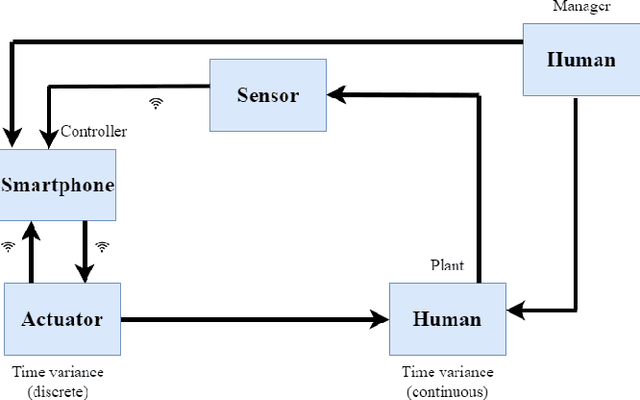

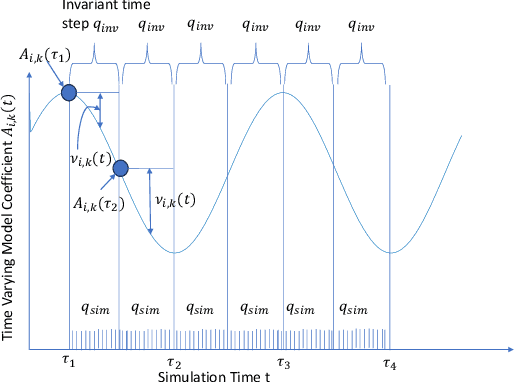
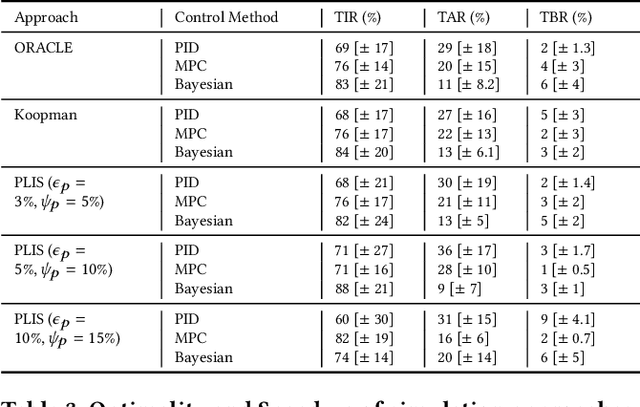
Abstract:Non-linearities in simulation arise from the time variance in wireless mobile networks when integrated with human in the loop, human in the plant (HIL-HIP) physical systems under dynamic contexts, leading to simulation slowdown. Time variance is handled by deriving a series of piece wise linear time invariant simulations (PLIS) in intervals, which are then concatenated in time domain. In this paper, we conduct a formal analysis of the impact of discretizing time-varying components in wireless network-controlled HIL-HIP systems on simulation accuracy and speedup, and evaluate trade-offs with reliable guarantees. We develop an accurate simulation framework for an artificial pancreas wireless network system that controls blood glucose in Type 1 Diabetes patients with time varying properties such as physiological changes associated with psychological stress and meal patterns. PLIS approach achieves accurate simulation with greater than 2.1 times speedup than a non-linear system simulation for the given dataset.
Transfer: Cross Modality Knowledge Transfer using Adversarial Networks -- A Study on Gesture Recognition
Jun 26, 2023Abstract:Knowledge transfer across sensing technology is a novel concept that has been recently explored in many application domains, including gesture-based human computer interaction. The main aim is to gather semantic or data driven information from a source technology to classify / recognize instances of unseen classes in the target technology. The primary challenge is the significant difference in dimensionality and distribution of feature sets between the source and the target technologies. In this paper, we propose TRANSFER, a generic framework for knowledge transfer between a source and a target technology. TRANSFER uses a language-based representation of a hand gesture, which captures a temporal combination of concepts such as handshape, location, and movement that are semantically related to the meaning of a word. By utilizing a pre-specified syntactic structure and tokenizer, TRANSFER segments a hand gesture into tokens and identifies individual components using a token recognizer. The tokenizer in this language-based recognition system abstracts the low-level technology-specific characteristics to the machine interface, enabling the design of a discriminator that learns technology-invariant features essential for recognition of gestures in both source and target technologies. We demonstrate the usage of TRANSFER for three different scenarios: a) transferring knowledge across technology by learning gesture models from video and recognizing gestures using WiFi, b) transferring knowledge from video to accelerometer, and d) transferring knowledge from accelerometer to WiFi signals.
Merging Deep Learning with Expert Knowledge for Seizure Onset Zone localization from rs-fMRI in Pediatric Pharmaco Resistant Epilepsy
Jun 08, 2023



Abstract:Surgical disconnection of Seizure Onset Zones (SOZs) at an early age is an effective treatment for Pharmaco-Resistant Epilepsy (PRE). Pre-surgical localization of SOZs with intra-cranial EEG (iEEG) requires safe and effective depth electrode placement. Resting-state functional Magnetic Resonance Imaging (rs-fMRI) combined with signal decoupling using independent component (IC) analysis has shown promising SOZ localization capability that guides iEEG lead placement. However, SOZ ICs identification requires manual expert sorting of 100s of ICs per patient by the surgical team which limits the reproducibility and availability of this pre-surgical screening. Automated approaches for SOZ IC identification using rs-fMRI may use deep learning (DL) that encodes intricacies of brain networks from scarcely available pediatric data but has low precision, or shallow learning (SL) expert rule-based inference approaches that are incapable of encoding the full spectrum of spatial features. This paper proposes DeepXSOZ that exploits the synergy between DL based spatial feature and SL based expert knowledge encoding to overcome performance drawbacks of these strategies applied in isolation. DeepXSOZ is an expert-in-the-loop IC sorting technique that a) can be configured to either significantly reduce expert sorting workload or operate with high sensitivity based on expertise of the surgical team and b) can potentially enable the usage of rs-fMRI as a low cost outpatient pre-surgical screening tool. Comparison with state-of-art on 52 children with PRE shows that DeepXSOZ achieves sensitivity of 89.79%, precision of 93.6% and accuracy of 84.6%, and reduces sorting effort by 6.7-fold. Knowledge level ablation studies show a pathway towards maximizing patient outcomes while optimizing the machine-expert collaboration for various scenarios.
EdGCon: Auto-assigner of Iconicity Ratings Grounded by Lexical Properties to Aid in Generation of Technical Gestures
Jun 02, 2023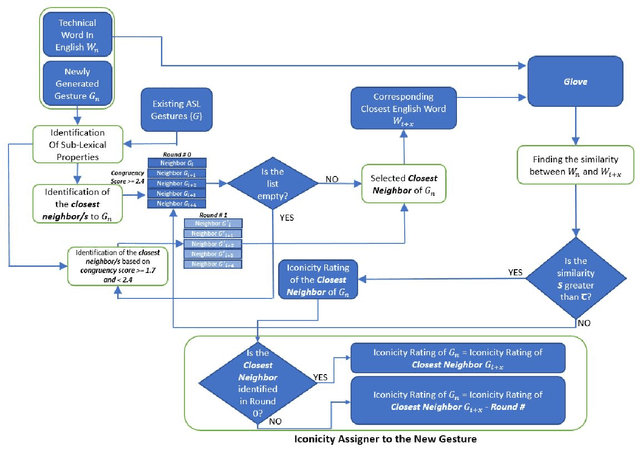
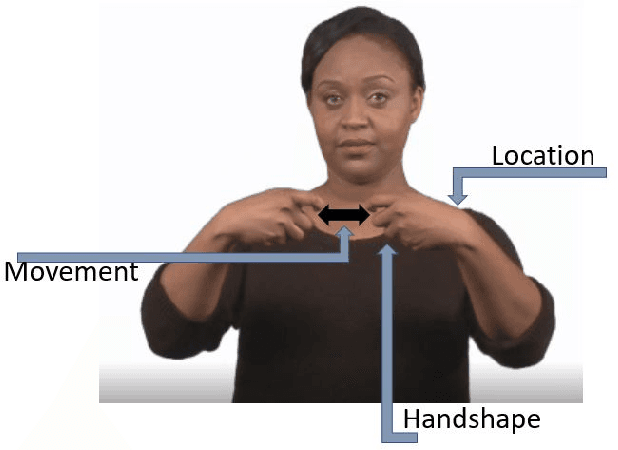
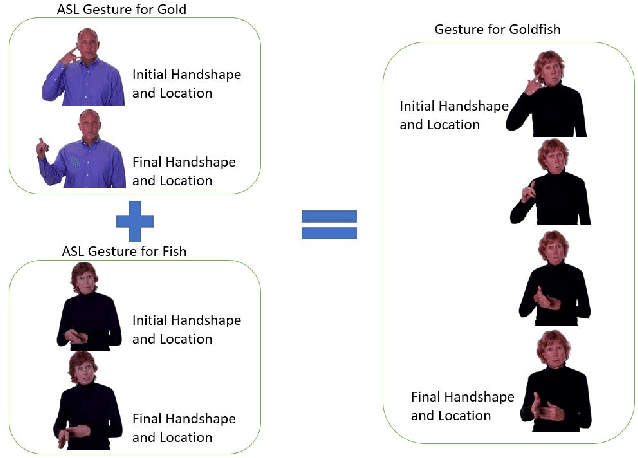
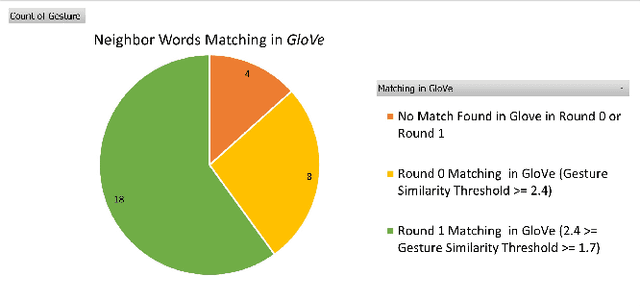
Abstract:Gestures that share similarities in their forms and are related in their meanings, should be easier for learners to recognize and incorporate into their existing lexicon. In that regard, to be more readily accepted as standard by the Deaf and Hard of Hearing community, technical gestures in American Sign Language (ASL) will optimally share similar in forms with their lexical neighbors. We utilize a lexical database of ASL, ASL-LEX, to identify lexical relations within a set of technical gestures. We use automated identification for 3 unique sub-lexical properties in ASL- location, handshape and movement. EdGCon assigned an iconicity rating based on the lexical property similarities of the new gesture with an existing set of technical gestures and the relatedness of the meaning of the new technical word to that of the existing set of technical words. We collected 30 ad hoc crowdsourced technical gestures from different internet websites and tested them against 31 gestures from the DeafTEC technical corpus. We found that EdGCon was able to correctly auto-assign the iconicity ratings 80.76% of the time.
 Add to Chrome
Add to Chrome Add to Firefox
Add to Firefox Add to Edge
Add to Edge